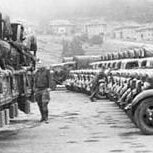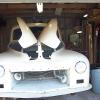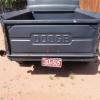Search the Community
Showing results for tags 'valves'.
-
I tried to track down as much as possible to see what has been offered up on the subject of adjusting the valves on the flathead 6. Setting aside all the suggestions for solo numbers, hot or cold, stopped or running, gloves or salve, I came up with the following, FOR THOSE READING THIS THREAD, USE THE RECOMMENDED GAP FOR YOUR CAR'S YEAR THE PROCESS IS CORRECT AND ACCURATE THIS IS A NEW IMPROVED IMAGE
- 42 replies
-
- 2
-

-

-
- adjusting valves
- valves
-
(and 1 more)
Tagged with:
-
Today I tweaked my valve adjustment using the NOT running procedure discussed here many times. I believe it is available on the tech section. Engine is smooth and quiet ! During rebuild I did set these cold. Then in the car I did the Running method . Although I thought I managed this ok, the valves were still I bit noisy. Certainly recomend the non-running adjustment.
-
I'm still in the engine rebuilding stage and it's time to do an initial cold engine tappet adjustment. After I get it running, I'll re-do the tappets hot. For now I just want them in the ballpark. How can I be sure the lobes on each cam are pointing straight down for each valve when I'm adjusting the gap? The book says the gap should be .014 cold for intakes and exhausts. ('51 B3B) I don't have the head on yet. Can cam lobe position be determined from piston height? Or timing gear position?
- 6 replies
-
- valve stem
- cold tappet adjustment
- (and 5 more)
-
I've completely torn down the engine on my 1950 Chrysler Windsor Sedan, as the engine was seized when I bought it. I have yet to collect any precision measurements (I don't own any machinist's tools), but I did notice a few things as I disassembled the engine, and I'd like to know if any of you have any advice. Primarily concerning me right now is the valve train. While some of the valves slid right out of their guides after I had removed their springs and retainers, there were a few that were so stubborn, they required vice grips, penetrating oil, and nearly an hour of twisting and tugging to remove. What's odd, is that aside from the damage inflicted by my vice grips, I couldn't find any apparent deformities on the stubborn valves. I'm wondering at this point if there's any good way to determine if the problem was my valves, valve guides, or both. Additionally, after finding what's available on Vintage Power Wagons, I've been considering the possibility of installing modern valve seats and valves to allow for the use of unleaded fuel. I hope to one day drive this car daily, and don't want to deal with tracking down and adding a lead substitute at every fill-up. Does anyone here have experience in running these fatheads on unleaded? Do the original valves ruin themselves if you do? This is my first engine rebuild, and any advice on the subject is greatly appreciated.






